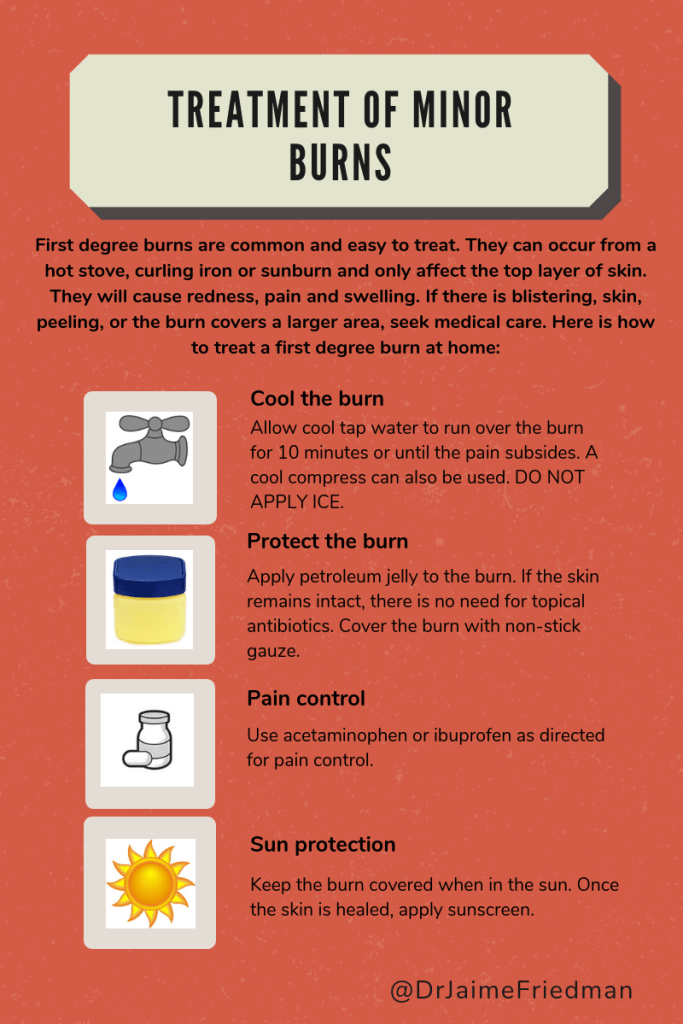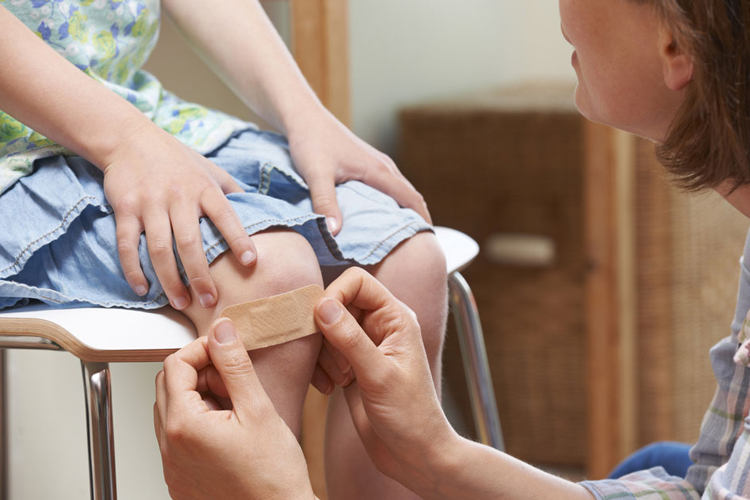Safety First
They say an ounce of prevention is worth a pound of cure. That means the most important thing you can do for injuries is to prevent them. I’ve written many times about safety and injury prevention on this blog. You can find information on car seats, helmet use, water safety, safe sleep, heat safety and even baby proofing. But we all know that no matter what we do to protect our children, accidents happen. They fall, scrape their knees and bonk their heads. It’s important for parents and caregivers to know how to handle minor injuries at home and when to seek medical care. I also recommend for parents and caregivers to take a CPR class and to have the phone number for poison control saved in their phones. (Hint it’s 1-800-222-1222)
Items to have at home
- Thermometer
- Fever/pain reducer
- Bandages
- Antibiotic ointment (generic triple antibiotic ointment is fine)
- Gauze (regular and non-stick) and tape
- Ice packs
- Antihistamine
- Elastic bandages
- Copy of child’s medical history, medications, allergies and phone numbers for doctors and specialists to take to the ER or give to babysitters
Minor scrapes and cuts
If your child falls and gets an abrasion, scrape or cut, you will want to clean it out to clear away debris and check the extent of the injury. Always be sure your own hands are clean with soap and water first. If there is minimal to no bleeding and the wound isn’t very deep, clean it and apply some antibiotic ointment. If the area is very raw and tender, cover it with a non-stick bandage. However, whenever possible it’s best to keep skin open once ointment is applied. Once new skin is healing in, you can keep it uncovered.
If you cannot control the bleeding or there is a deep or wide cut, seek medical care. Furthermore, if a minor wound continues to swell, gets increasingly red or painful, or oozes thick material, seek medical care.
Minor burns 
Burns occur regularly in the home. Hot stoves, curling irons, hot beverages can all cause minor to severe burns. Even a sunburn can be treated like a mild burn at home. However, sunburns can also be severe so don’t forget sunscreen use.
Minor, or first degree, burns only damage the outer layer of the skin and can be treated by cooling off the skin with water, not ice, and applying a protective layer of petroleum jelly. The skin will swell, look red and be tender so you will want to provide pain control as well. Second degree burns damage the outer layer of the skin, as well as the layer underneath it. That will cause blistering and peeling of the skin. These burns require medical care to assess the damage and treat the burn because they can be susceptible to excessive fluid loss and infection. Third degree burns occur when deep layers of the skin are damaged. These sometimes require hospitalization for pain and fluid control, infection prevention and may result in a skin graft to allow for healing. If you are worried that your child has a second or third degree burn, seek medical care.
Sprains and strains
Children fall. Whether they aren’t paying attention to what they are doing, are horsing around or just simply playing, they are susceptible to injury. Even young athletes are also susceptible to sprains and strains. If your child has an injury, first assess for any open skin or deformity. These would be reasons to seek medical care right away. Both fractures and sprains will cause swelling, pain and bruising so these symptoms don’t differentiate between the two. Therefore, the best thing to do for an injury that you don’t think requires immediate attention is to apply ice, immobilize with an elastic wrap, elevate if possible and provide pain medication. The elastic wrap can also help reduce swelling by providing compression. If symptoms persist, have your child seen by their pediatrician to decide if an x-ray is needed.
Head injuries
Head injuries can be scary for parents to observe. We have so much more information now on the risks and treatment of concussions. Parents and coaches are more aware of the need to address head injuries immediately, assess for concussion and manage the recovery. But, not every head injury causes a concussion. For example, toddlers and young children fall and hit their heads all of the time. They usually get right back up and start playing again and don’t typically need any further care. However, any head injury that results in a loss of consciousness, altered mental status, severe headache or vomiting should be checked right away. When in doubt, have your child see the doctor. A deeper discussion of concussions would take another blog post, but for more information click here. You can also watch me discussing concussions on Fox 5 San Diego here.
As always, if you are ever concerned about your child’s injury, seek medical care.



